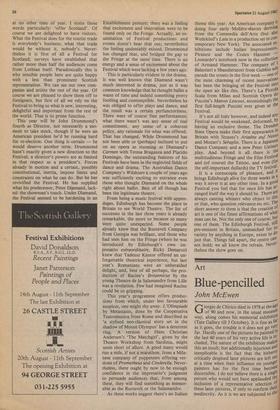Art
Blue-pencilled
John McEwen
Giorgio de Chirico died in 1978 at the age of 90 and now, in the usual museuni way, along comes his memorial exhibition (Tate Gallery till 3 October). It is fine as far as it goes, the trouble is it does not go verY far. Hardly one of the pictures he painted In the last 60 years of his very active life is Irl" cluded. The nature of the exhibition makes this an insult; but additionally injurious and inexplicable is the fact that the hitherto critically despised later pictures are left ont at a time when their influence on younger painters has for the first time become discernible. I do not believe there is a single person who would not have applauded the, inclusion of a representative selection °I these later pictures, if only to confirm their mediocrity. As it is we are subjected to the censored selection of the Museum of Modern Art in New York, the institution responsible for instigating the exhibition and the one that, above all, sanctioned the hostility to the later pictures during de Chirico's lifetime. What an opportunity has been missed for the Tate to upstage its superior. Now we shall just have to twiddle our thumbs till an exhibition of the later Pictures is organised, as it surely very soon will be.
De Chirico, of course, would not have Minded one bit. It would merely have reconfirmed the low opinion he had of
everything that came to be associated with ,
modern art'. His cynical practice in later Years of churning out copies of some of the Most revered of his early works and even hing the dates, seems in accordance with i attitude. There were no depths to which he would not stoop in order to have the Pleasure of seeing his dishonesty reciprocated by some outwardly respectable member of the art world. He was a very angry man and a very lonely one too. And it Is probably this overwhelming mood of loneliness, of the melancholy of life, that has made his early pictures of deserted piaz- zas and distant trains such an influence on the mood and imagery of films as much as the paintings of the surrealists — and won him a popular audience over the years. The mood is ambiguous and oppressive, the attitude unapologetically nostalgic. De Chirico invariably looks back to a past that is better than the present. It is this that Unites the early visions of industrialised towns with the later ones of Arcadia, and it Was this repudiation of 'progress' that surely lay at the root of his bitter and compounded opposition to modern art. Another factor that unites the revered early paintings and the despised later ones is attention to technique. The early pictures are beautifully painted, and it was tech- nique that absorbed him above all else in his later work. Such continuities make the omission of the later pictures all the more indefensible; and to read Mr Rubin, the ar- biter in this matter, justifying his choice on 1,,,_11e grounds of 'ethos', only makes it worse. what does emerge from this sawn-off selec- _,tron is that between his two nostalgia dominated periods, de Chirico painted a Series of closely viewed assemblages, iconic to their abstract strength, in which the delicacy of his touch and the individualism °f his colour reach an apogee. It is lack of this colour — the sonorous terracottas, midnight blues, dawning greens, loss greys — that seems the greatest loss of his later work, but we shall have to watt for the true memorial exhibition to be compiled before this, and de Chirico's total Worth, can be fairly judged. The Arts Council-sponsored retrospective °f the work of Elizabeth Blackadder has tome to rest, after a long tour, at the Royal Academy (till 22 August). She herself is a member of both the Scottish and English Academies, and certainly livens up the Lon- don Summer Show. Like Matisse — and at her most whimsical she is very much a Women's Rural Institute version of him she clearly wants her painting to give the same sort of satisfaction as a comfortable armchair after a hard day. This is no doubt why her work appeals so much to MPs. She is well trained but unimaginative, which means she never breaks the bounds of regionalism. In recent times this lack of im- agination has driven her to more and more twee and oriental effects. Her little inven- tories of the objects she hoards were tougher when worked in oils, and it is as an honest watercolourist of flowers that she is currently most acceptable. Chinese Tradi- tional Painting 1886-1966 can also be seen at the Academy (till 29 August): a display of Chinese academicism on the slide.



































 Previous page
Previous page